Some of the links in this post may be affiliate links.
This is your ULTIMATE, complete care guide for Aglaonema or Chinese Evergreen!
In this post, you will find comprehensive care tips, solutions to frustrating problems you may be having, instructions on how to revive your plant, and an introduction to the huge array of the varieties out there that you will drool over!

Truly an amazing, versatile and easy to grow houseplant, Aglaonema is no longer the boring dark green plant that you see planted in shopping malls!
Fairly slow growing, Aglaonema commutatum (botanical name), has a few common names: Chinese Evergreen, Philippine Evergreen, and Poison Dart Plant.
Aglaonema tolerates poor light extremely well, comes in a staggering array of leaf colors, and is among the easiest houseplants you can grow!
Now let’s dive into how you can make your Chinese Evergreen or Aglaonema thrive!
Table of Contents
CHINESE EVERGREEN CARE
LIGHT
This is an amazingly versatile plant when it comes to light conditions. Aglaonema species are native to humid and shady tropical forests in Asia, so this gives you clues on care.
Fortunately for us, this is one of the best plants for low light conditions inside the home. These plants are perfectly happy in front of a Northern exposure window (indirect light), or even Eastern exposure (morning sun) window.
Don’t let these plant sit in full sun though, and avoid any sun in the middle part of the day! A couple hours of morning sun or late afternoon sun is perfectly fine, and even beneficial.
Although it is preferable to have these plants right in front of a window, they are one of the few plants that will also do fine a few feet from a window.
If you think about the jungle floor where these grow, it can be pretty dim, and this fact makes it a great low-light plant for the home.
Aglaonema will even do pretty well in office settings that have no windows present, as long as there is fluorescent lighting on during the day. I used to have this plant in a windowless office and it did just fine!
And of course, if you have grow lights, they will thrive under these.
Be sure to turn your Aglaonema every week or two to encourage even growth and a more balanced plant.
If you keep them in the same orientation for too long, all the leave will bend towards the light (a phenomenon known as phototropism) and your plant will look unbalanced.
One word of advice though, if you have a highly variegated or particularly colorful variegated Aglaonema, such as a pink one in the photo below, these varieties will need a little more light than darker green ones in order to maintain their beautiful color.
If you keep these in conditions that are too dark, their colors will wash out and become “blah.”
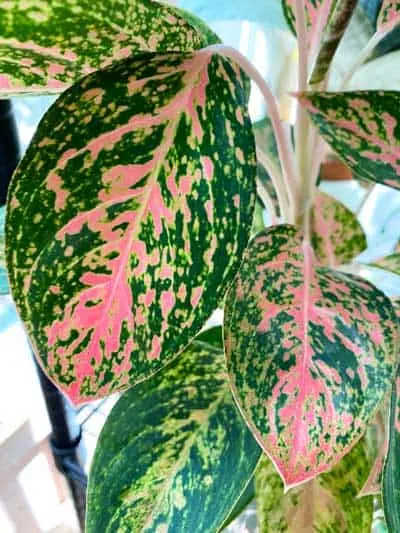
TEMPERATURE
Chinese evergreens are definitely freeze babies, so always avoid any cold rooms or cold drafts.
They will sit and sulk, and worse yet, if you keep your plant cold AND wet, you’ve set up prime conditions for root rot.
Ideal temperatures are 70-85F (21-29C). Try and avoid cooler temperatures below 60F (16C), especially for long periods.
In addition, avoid areas in your home or office that have heating or cooling vents and keep away from any drafty windows and doors.
If you live in a climate that has cold winters, and you have rooms that are particularly cool during the winter, you may want to move your plant to a warmer room.
I always say that if you are comfortable, your plant will be comfortable too, so normal room temperatures are just fine.
SOIL MIX
My “standard” blend that I use for most of my leafy tropicals works beautifully for Aglaonema.
I simply mix 3 parts of Miracle Gro potting mix with 1 part perlite.
This provides a nice, all-purpose, well draining soil mix for most tropical houseplants and works exceedingly well!
If you’d like a more detailed guide on this topic, check out my best soil for Aglaonema blog post.
If you’re looking for an amazing potting mix that you can use straight out of the bag for your Aglaonema, check out the Rainforest Soil Blend from Oh Happy Plants. This is an amazing mix and you will get 10% off at checkout automatically if you use my link.
WATERING
This section is critical so please read this carefully. Actually, all the advice on this page is important because having a beautiful specimen is all about consistency in care and having various aspects of care correct!
Always water your Aglaonema thoroughly. Make sure that you moisten all of the soil ,so circle that watering can all around the pot and keep watering until water comes out through the drainage holes.
Drainage holes are a must. Don’t let anyone tell you otherwise.
You should allow the top 1-2 inches of your plant’s soil to dry out before thinking about watering again.
I’ve included a section on problems near the end of this post, but this plant does not like to dry out completely. In fact, it hates it. Nor does it like to stay wet all the time, so you’ll have to strike a happy medium.
And please, for your own sanity and health of your plants, do not use moisture meters. They are junky and drive the wrong behavior.
I feel so strongly about this that I wrote a blog post explaining the 3 big dangers of using soil moisture meters.
FERTILZING
For all my tropical foliage plants, I use an amazing fertilizer called Dyna-Gro Grow.
It is a premium, complete, water-soluble houseplant fertilizer that contains all the micro and macro nutrients that a plant needs to grow and thrive. With consistent use, alongside good growing conditions, you will see a big difference in your plants!
I highly recommend Dyna-Gro Grow and use it for the majority of my own houseplants.
In general, I like to fertilize most of my tropical foliage plants dilutely with every watering by adding 1/4 teaspoon per gallon of Dyna-Gro Grow during the active growing season.
For Aglaonema, which is a relatively slow growing plant in general, it is probably better to use my fertilization method described above for every other watering.
Don’t fertilize in the winter when your plant is not growing.
HUMIDITY
Aglaonema is native to very warm and humid areas in its natural habitat. High humidity indoors would benefit these plants, however they are very tolerant of average indoor humidity!
In my sunroom, where I keep the majority of my plants, I do run a humidifier during the months when we heat our home. I try and maintain humidity levels between 40-60%.
There are various ways to increase humidity for houseplants. But contrary to popular belief, misting does not increase humidity!
Read all about this topic, as well as my recommended humidifier, in my blog post on how to
If you do run a humidifier, make sure to gently circulate the air as well (especially if you have a lot of plants in your room), as this will help deter fungal problems.
PROPAGATION
There are a few ways to propagate your plant.
The quickest way, if your plant has multiple stems growing out of the pot, is to simply take the plant out of the pot and carefully separate the rootball so that you have multiple plants to pot up.
If your plant has become leggy, you can make a stem cutting, and root it either in soil or water.
SOIL PROPAGATION OF AGLAONEMA CUTTINGS
The simplest way to propagate is to insert your cuttings directly into a pot with soil. Simply make a cutting that has 2-3 inches of stem and insert into a 50/50 mix of soil and perlite. This make a great blend to root your cuttings.
Keep your cuttings in a bright area with no direct sun, and aim to keep your soil moist. Moist soil is important while you’re rooting cuttings.
And don’t worry about “overwatering” because all that perlite will keep the mix nice and fluffy and full of air so there will be no danger of root rot.
Maintaining higher humidity is beneficial as you’re propagating, but Aglaonema will root pretty easily regardless.
WATER PROPAGATION OF AGLAONEMA CUTTINGS
Many people struggle with transferring cuttings into soil that have been previously rooted in water, but if you follow my care tips in this post, you should not have a big problem.
I rooted the cutting of my Aglaonema ‘Cutlass’ below in water:
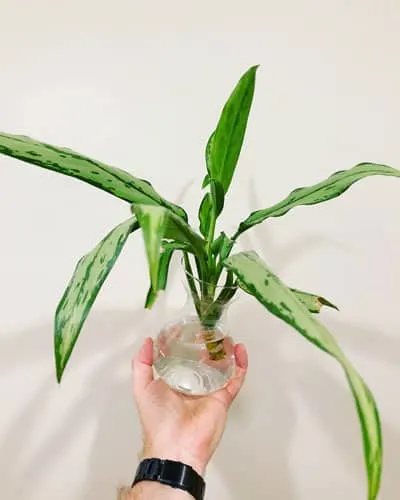
Once the roots were about an inch long or so, I transferred it into a pot. Two years after the cutting was taken, here is what the plant looks like now.
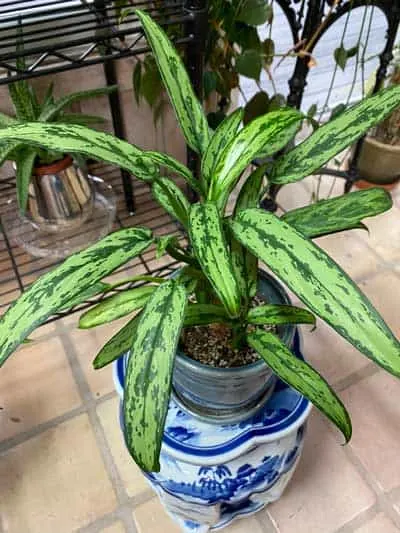
As you can see, growth is pretty slow, but it has grown two additional stems from the soil.
Don’t be shocked or discouraged if one of the lower leaves yellows while your’e propagating. Your plant will recover.
For a dedicated post on propagation, check out my post on how to propagate chinese evergreen. I have detailed instructions on how to propagate with 5 different methods.
AGLAONEMA VARIETIES
One of the reasons I love this genus of plants so much is that there are SO many different varieties, including many Aglaonema with striking, very colorful variegation!
Take a look at just some of the amazing, colorful varieties of Aglaonema out there. Remember that the really colorful ones tend to need a little bit more light than the plainer green ones in order to maintain their vibrant color.
Aglaonema ‘Lady Valentine’
A stunning pink Chinese evergreen! Who wouldn’t love to get their hands on this one?
The pink leaves with green speckles are stunning!
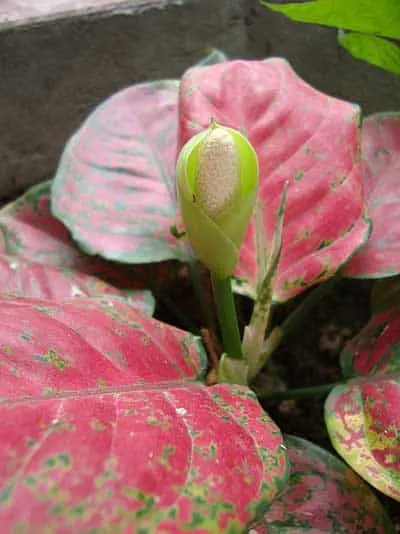
Aglaonema ‘Siam Aurora’
Heavily edged with pink, the veins are also pink. The combination of green and pink on the large leaves is quite striking.
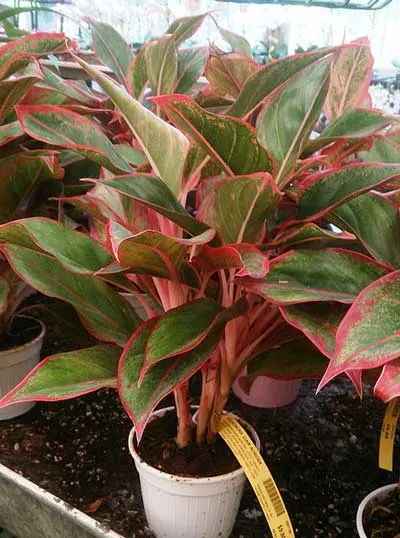
Aglaonema ‘Sparkling Sarah’
The beautiful pink midrib on the leaves and splashes of pink variegation is just lovely.
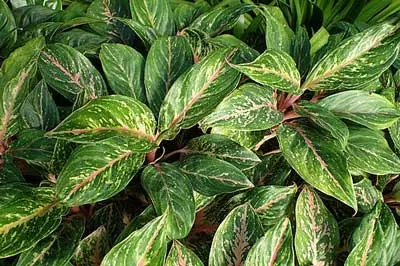
Algaonema ‘pictum tricolor’
Pictum tricolor is the holy grail of Aglaonemas. It is hard to find, very expensive when you do find it, and trickier to care for than other Aglaonemas. Be sure to cut the flowers off on this one if they do appear in order to keep the foliage in the best shape.
Aglaonema ‘Silver Queen’
This one is a pretty common and popular variety. The leaves are beautifully marbled and this is an especially easy-care Aglaonema.
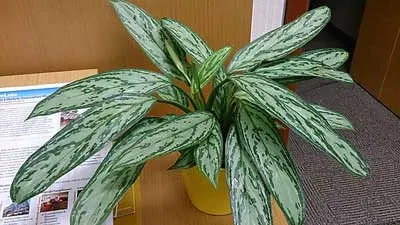
Aglaonema ‘Maria Christina’
Similar to ‘Silver Queen’ but with different shades of green and less silver on the leaves, this one is equally as easy to care for and commonly available.
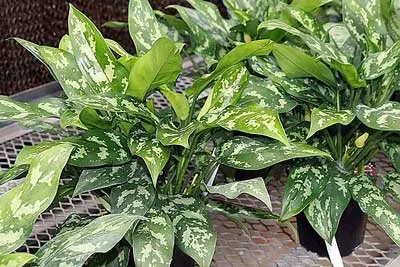
Aglaonema ‘Cutlass’
I love this variety for the narrower leaves that makes it so distinct.

Aglaonema ‘Snow White’
Lots of white variegation on these leaves. So much so that it reminds me of Dieffenbachia!
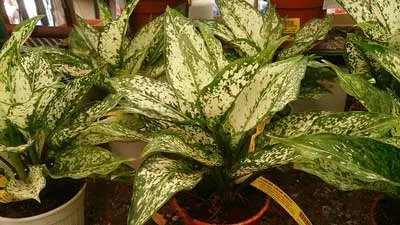
Aglaonema ‘Emerald Beauty’
Emerald Beauty is one of the more common Aglaonema plants, but still one of the best!
AGLAONEMA PROBLEMS
CURLING, LIMP, OR DROOPY LEAVES
So many plant woes are caused by extremes in soil moisture, and this is another example.
If your leaves are curling and start to appear droopy, check your soil. In most cases, your soil has probably gone completely dry. We’ve all done this!
If your soil has gone really bone dry, you may have to work at it a little in order for your soil to accept moisture again.
Have you ever watered a plant that has gone super dry and when you try and water, the water just goes straight through very quickly and doesn’t seem to absorb into the soil?
To fix this, you can just continually run water several times through the pot until your soil has accepted more water. You can often tell the difference by picking up the pot. It will feel much heavier once the soil is saturated.
Or you can let your plant sit in a container of warm water (don’t use cold), and allow the plant to absorb water from the bottom. You can use a bucket, a bathtub, a plastic tray, etc. Just make sure you have at least 2-3 inches of water and give it a good hour or so before you discard excess water.
YELLOWING LOWER LEAVES
Is it normal for an old leaf to turn yellow eventually? Absolutely.
But you should always check your soil moisture as soon as you see any yellow leaves. Especially if multiple yellow leaves seem to appear very quickly on your plant.
More often than not, yellowing leaves are caused by improper soil moisture (either too dry or too wet).
I know when I’ve ignored my plant and let it get super dry, the lower leaves will quickly yellow. Do this repeatedly, and you will have a leggy plant.
To prevent yellowing leaves, you need a balance in soil moisture. Never allow your soil to get completely dry (especially for extended periods) and never let your plant stay wet for extended periods.
Aglaonemas don’t like wet feet either, so make sure to discard any excess water after it drains out of the pot (and always have a drainage hole!). Your plant will quickly get root rot if it sits in water or soil that is continually wet.
The key to preventing yellowing leaves is to aim to have the top inch or two of soil dry out before watering again. This is the main key to avoiding yellow leaves.
CONSISTENCY is very important in plant care!
There are other reasons why leaves can turn yellow. Read my blog post dedicated to why your houseplant leaves are yellowing and what you can do to fix it.
BROWN, CRISPY LEAF TIPS
If your Chinese Evergreen has brown, crispy leaf tips, it is most likely due to your soil being too dry. Feel the soil to be sure.
If it is dry, give it a good watering. Although your brown tips won’t turn green again, with consistently good watering, all your future leaves should look good.
For more on this topic, check out my in depth blog post on the top 6 reasons why plants get brown, crispy leaves.
SHOULD YOU CUT OFF THE FLOWER?
There is much controversy on this topic, but I will give you my thoughts. Take a look at a flower which is almost done on my Aglaonema ‘Cutlass’ and a new bud that is about to open soon.
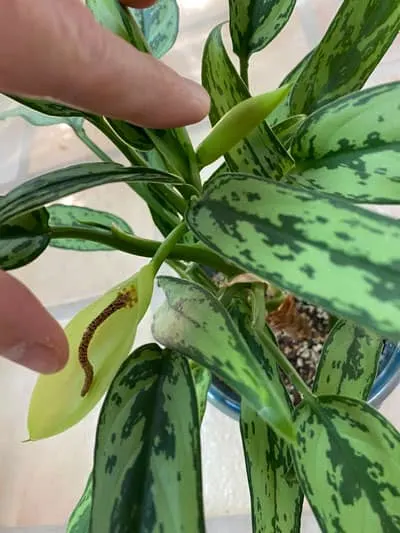
The bottom line is that no one grows Aglaonema for their flowers! I cut these buds off right after I took the photo.
I would recommend cutting the flower buds off as soon as you can clearly see that they’re flower buds and not leaves. The thought is that the plant can then focus on growing the foliage that we want, instead of directing energy to the flowers, which aren’t too terribly interesting to look at anyway.
Does it really matter that much? In many Aglaonemas it probably won’t make a gigantic difference, with one potential notable exception.
I haven’t grown Aglaonema pictum ‘Tricolor’ but I have heard from many people that their plants suffered a quick demise after it bloomed, so you may want to cut that one off for sure if you have this particular plant (if you can even find it in stock anywhere, that is!)
For a more in depth discussion, refer to my Aglaonema Flowers blog post to learn more.
FIXING A LEGGY AGLAONEMA
Over time, as a result of inconsistent care, especially if you’ve let your plant dry out and the lower leaves have yellowed, your plant can become leggy. Older plants will often have this issue.
Fortunately you can fix this by cutting off the leggy part, rooting it in water, and then planting it in soil. See the propagation section in this blog post for details.
DEALING WITH PESTS
We all deal with pests in houseplants. It is inevitable! If your houseplant care has not been consistent and your plant has become stressed (from drought, cold, etc.), your plant will be more prone to pests.
Some of the most common pests you might encounter on your Aglaonema are spider mites, mealybugs, and scale.
Check out my blog post on dealing with spider mites naturally without harsh chemicals. Many people like using Neem oil, but I find that it smells bad and it leaves a residue on the leaves so I use other methods which I describe in my post.
IS AGLAONEMA TOXIC?
Chinese evergreen is toxic to dogs and cats according to the American Society for the Prevention of Cruelty to Animals (ASPCA) because it contains calcium oxalate crystals.
If you cat or dog has ingested Aglaonema, they may experience pain, irritation and swelling in the mouth, tongue and lips, and even vomiting and difficulty swallowing.
Do you have any Aglaonema or Chinese Evergreen plants? Which variety is your favorite? Comment below! I’d love to hear from you.

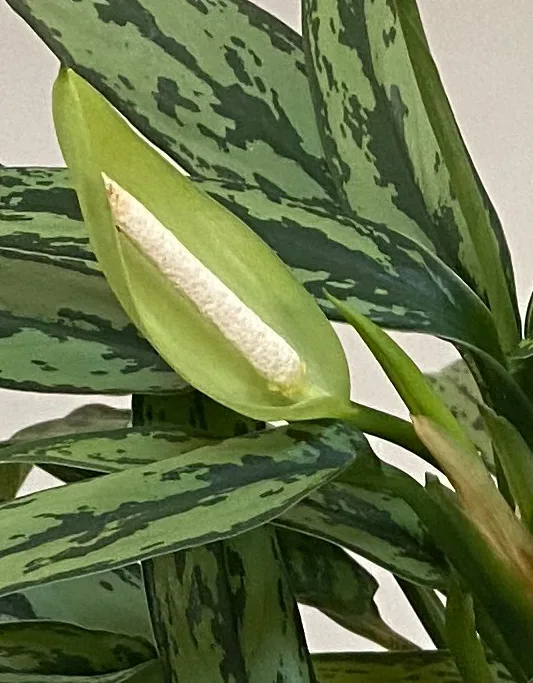
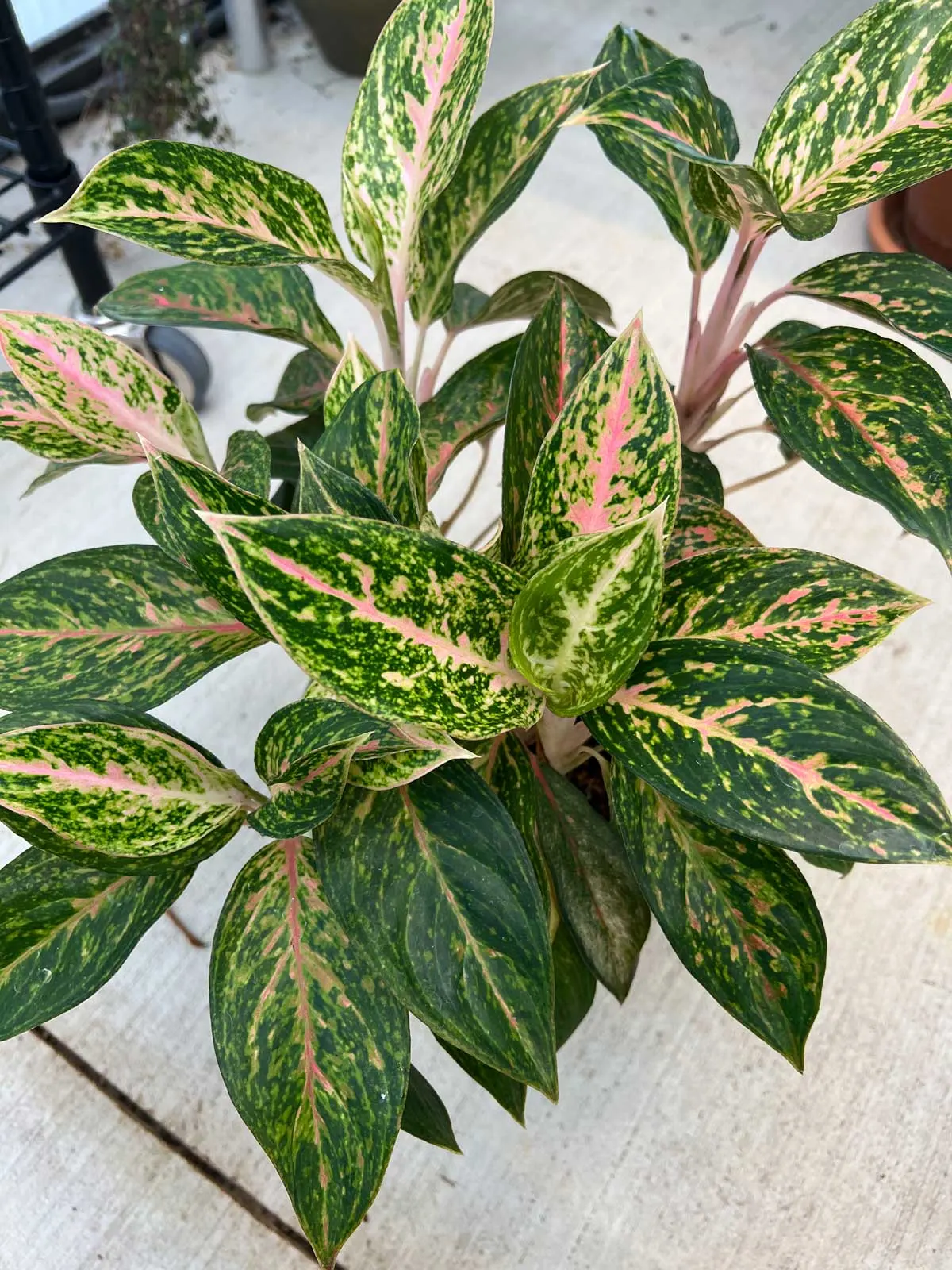
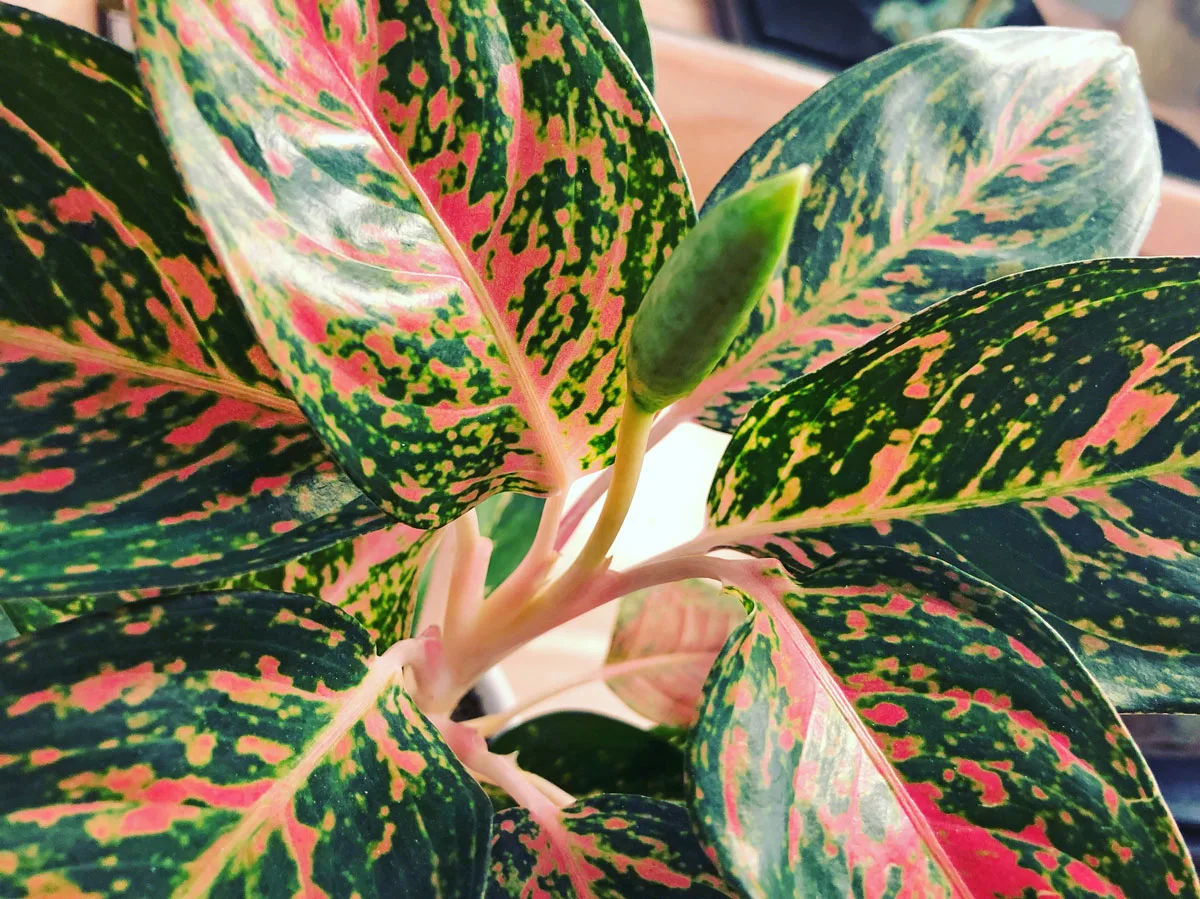
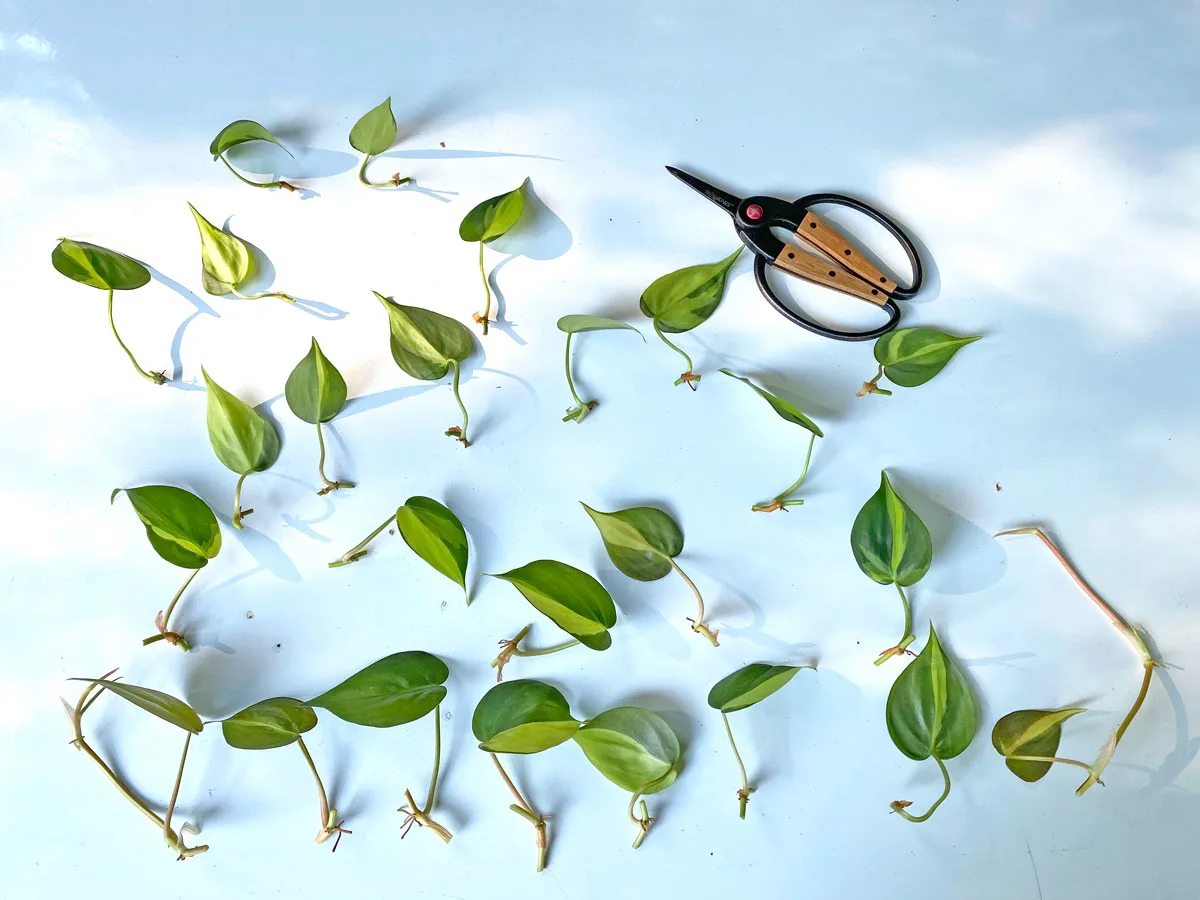
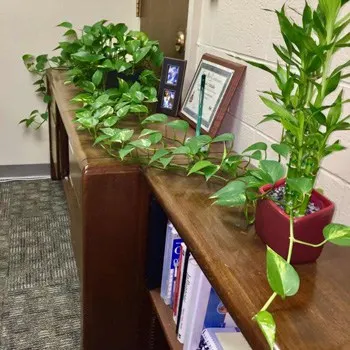
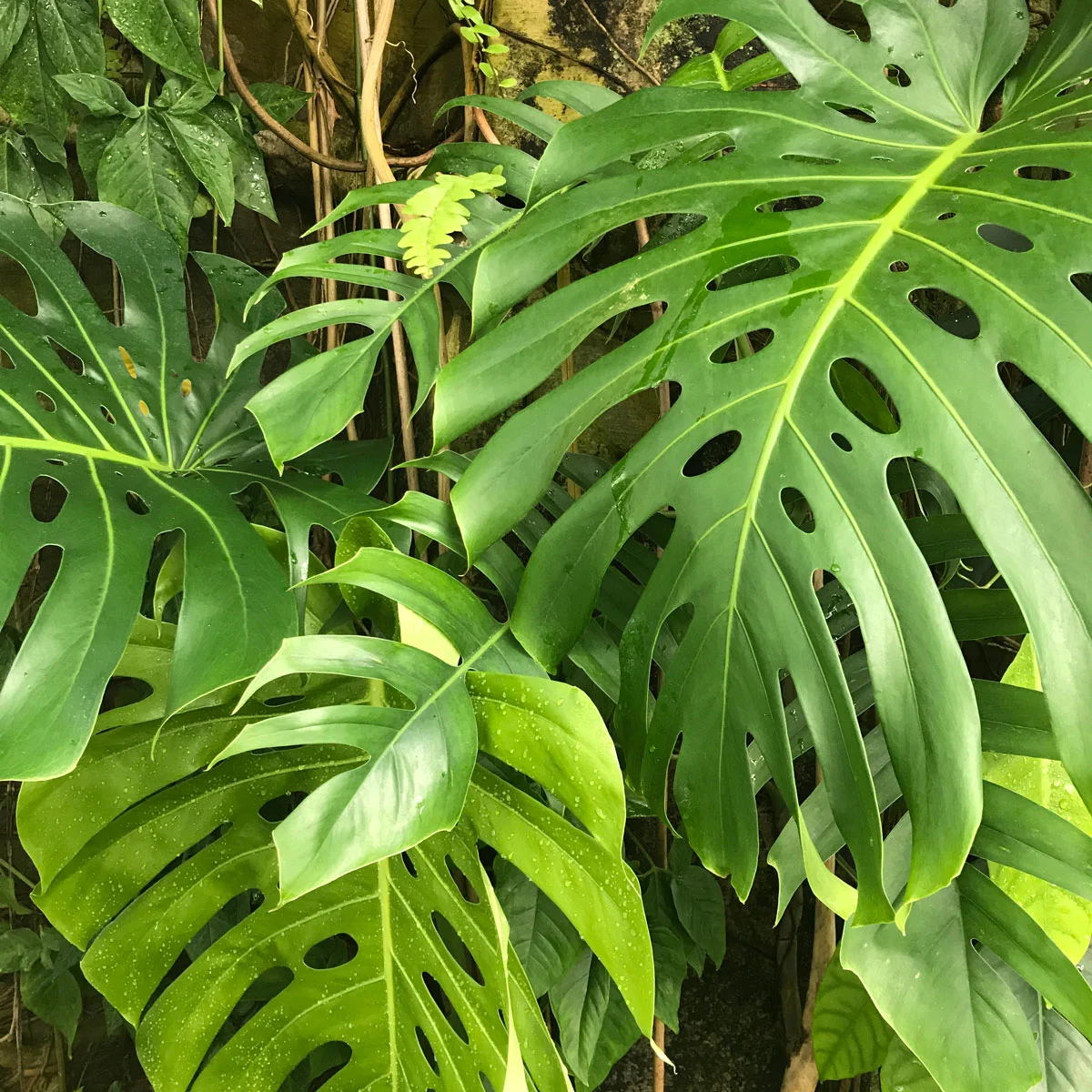
Brooke
Sunday 21st of April 2024
Hello! I just bought mine, and it seems to have little crystal sap balls on it. Is this normal? When wiped off, they are sticky and feel like sap from a tree. Thank you for your help!
Raffaele Di Lallo
Sunday 21st of April 2024
Hi Brooke! It sometimes happens with these plants. The stick sap can also come from pests. Do you see any pests? Some pests excrete a "honeydew" that is sticky (such as mealybugs or scale). If you don't see any pests, there is nothing to worry about!
kirstyn
Sunday 15th of January 2023
Need some help! Today a couple hours after I watered it, discovered that half of the pink dalmation that has been thriving since August was flopping to one side and saw that a huge stalk with numerous leaves was splitting away from the base of the stem.
At first I lightly twisted and it fell completely off, and I quickly put into the potting mix, then I changed tactics, placing the stem in water instead. This gorgeous plant was always very healthy and was shooting out new leaves very frequently - at least nine or 10 since August, and keeps producing new leaves as of today, in mid-January! I've only been watering once every two weeks since early Dec.
It sits near the window with natural sunlight and also has growth light overhead which stays on when it's darker out. Maybe was getting a bit too much light given how quickly the new leaves appeared, one after the other. The section that split off was also quite hefty and top heavy which makes me think the stem was not able to support its weight. What can I do to save the plant and the stalk that fell off - should it be kept where it is in water until roots form and also, what if anything should I be doing to address the section where the stem split close to the base? THANKS
Raffaele
Sunday 22nd of January 2023
Hi Kirstyn! Sorry to hear about your plant! I would just let it root in water, and then plant it up once it forms roots. The process can be quite slow so have some patience. As far as the original plant where it broke off, you can just leave it alone. When you water, avoid getting that part wet (where it snapped off). You should be ok.
Rebekah
Friday 30th of December 2022
Hello Thank you for your website. Very helpful. I recently purchased a red Siam aurora plant at Home Depot, and after pruning off the frozen leaves, it’s now getting dark brown/black edges. I have not watered it since I bought it 4 days ago due to soil still being moist and it is away from windows and my heat vent and getting the proper light it needs. What can I do to help my plant? Does it have a fungus? I do have neem oil. Thank you!
Raffaele
Saturday 31st of December 2022
Hi there! It sounds like your plant has been through some cold damage so I would give it some time. You mentioned that it's away from a window? How far? I would place it right in front of a window. Either one that gets no direct sun, or one that gets some morning sun. You should start to see some improvement slowly.
Elizabeth
Thursday 8th of December 2022
My agla has already lost one leaf to yellowing and is about to lose another. I'm hoping moving her from my cold window to my office that tends stay quite warm for the winter will help heal her! Thank you so much for this care guide
Raffaele
Thursday 8th of December 2022
Hi Elizabeth! I'm glad you enjoyed the post. That definitely should help a tremendous amount. Be careful not to let the potting mix dry out completely as this can cause the lower levels to yellow as well. Let the top inch dry out, and then water and you should be golden. It's newer, warmer environment will cause the potting mix to dry out more quickly, so keep an eye on it :-)
Susie Shields
Sunday 13th of November 2022
I follow your articles and always come away with ideas about how I can take better care of all my babies. I have been trying to root stem cuttings from my Aglaonema for 4 months in water. They aren’t dying, just no roots. I want to plant it back in soil and have read that can sometimes be a problem. Should I take the cuttings out of the water and put in soil at this point? I had put them directly in soil initially and they started to look very bad so I put them in water. The remaining stem that I cut from are just now starting to show a sprout starting. Should it really take this long to regrow?
Raffaele
Monday 14th of November 2022
Hi Susie! Glad you find my site useful! And hang in there. They take a long time to form roots. Mine took a long time too, but once they rooted and I planted them, they're doing beautifully now. If yours is not in front of a window, by all means do so.